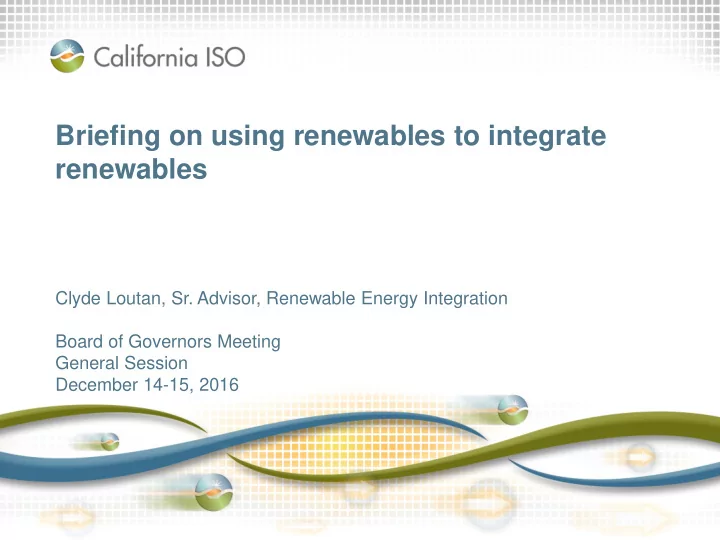

Briefing on using renewables to integrate renewables Clyde Loutan, Sr. Advisor, Renewable Energy Integration Board of Governors Meeting General Session December 14-15, 2016
Can variable energy resources provide essential reliability services to reliably operate the grid? • NERC identified three essential reliability services to reliably integrate higher levels of renewable resources – Frequency control – Voltage control – Ramping capability or flexible capacity • Test results demonstrated the plant has the capability to provide these essential reliability services • Advancement in smart inverter technology allows VERs to provide services similar to conventional resources • VERs with the right operating characteristics are necessary to decarbonize the grid Page 2
The ISO, First Solar and NREL demonstrated how a 300 MW solar PV plant can provide essential reliability services Test Performance Ramping • Ramp its real-power output at a specified ramp-rate • Provide regulation up/down service • Provide reactive power support in various modes - Control a specified voltage schedule Voltage - Operate at a constant power factor - Produce a constant level of MVAR - Provide controllable reactive support (droop setting) - Capability to provide reactive support at night • Provide frequency response for low frequency and high Frequency frequency events - Control the speed of frequency response - Provide fast frequency response to arrest frequency decline Page 3
Demonstrated how a solar plant ramping capability can be controlled to a specified ramp rate Page 4
Demonstrated that the solar plant was able to accurately follow the 4-second regulation signals Page 5
Regulation accuracy of the solar plant demonstration exceeded accuracy of conventional resources Regulation Up Accuracy 100% 90% 80% 70% 60% 50% 40% 30% 20% 10% 0% Steam Pump Hydro Combined Limited Gas Solar PV Solar PV Solar PV Turbine Turbine Cycle Energy Turbine (Middle of (Sunset) (Sunrise) Storage the Day) Blue bars taken from the ISO’s informational submittal to FERC on the performance of resources providing regulation services between January 1, 2015 and March 31, 2016 Page 6
Voltage Control: Test demonstrated the plant’s capability to control system voltage at night By changing the reactive output of the plant from +100 MVAR to -100 MVAR, the voltage at the POI changed from 242 kV to 227 kV (Green curve) Page 7
Solar plant frequency responsiveness was similar to or better than conventional resources Conventional Events Performance Resource Solar PV response to high Compared to a frequency combined cycle plant Solar PV response to high Compared to a hydro frequency plant Compared to a hydro Solar PV response to low frequency plant Solar PV ability to arrest frequency Compared to a hydro decline within the inertia response plant timeframe (Fast frequency response) Page 8
Solar response similar to a combined cycle plant using 3% governor-like droop setting for high frequency event 204 202 200 MW 198 196 194 192 10:29:29 10:29:31 10:29:33 10:29:35 10:29:37 10:29:39 10:29:41 10:29:43 10:29:45 10:29:47 10:29:49 10:29:51 10:29:53 10:29:55 10:29:57 10:29:59 10:30:01 10:30:03 10:30:05 10:30:07 10:30:09 10:30:11 10:30:13 10:30:15 10:30:17 10:30:19 10:30:21 10:30:23 10:30:25 10:30:27 10:30:29 10:30:31 10:30:33 10:30:35 10:30:37 10:30:39 Actual Solar Response Expected Response (Combined Cycle Plant) Page 9
Solar response similar to a hydro plant using 5% governor-like droop setting for high frequency event Page 10
Ability of solar plant to respond and arrest frequency decline similar to a hydro plant for a low frequency event Page 11
Next steps • Continue to share test results: – NERC’s Essential Reliability Services Task Force – NREL & GE Technical Review Committee for the West Wide study on frequency response – FERC staff • Evaluate the existing solar fleet to determine the amount of capacity able to provide essential reliability services • Further explore additional opportunities for renewable resources to participate in the various markets for energy and ancillary services • Issue final report in 4 th quarter of 2016 Page 12
Recommend
More recommend